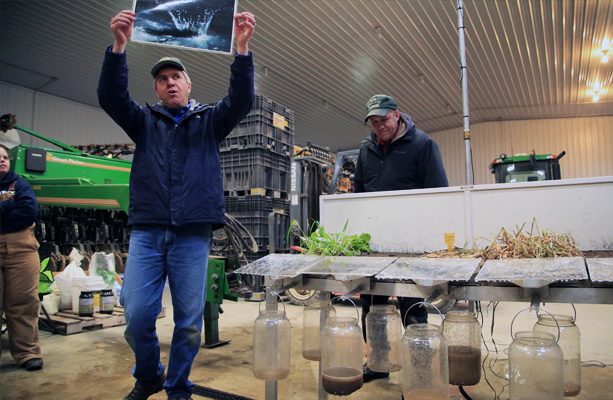Promoting Agricultural Innovation to Improve Water Quality
The Power of Perception: Helping Farmers Leave a Legacy of Healthy Land
- By Randall Hyman
Lake Erie has made an impressive comeback since the 1960s when some parts were declared dead from industrial pollutants. Eleven million people, from Toledo to Cleveland to Buffalo, depend on Lake Erie for their drinking water, and the lake supports a rich ecosystem. Now agriculture, not industry, threatens its shores.
Northern Ohio is carpeted with farms. Heavy rains flush a flood of agricultural silt and fertilizer into rivers feeding the lake. While phosphorus-packed fertilizer fortifies crops, it also bolsters massive blooms of toxic blue-green algae.
It has been decades since the first incentive programs were introduced to generate change in farming practices. Despite good intentions and programs to promote conservation practices, the lakes continue to struggle with nutrient pollution. The Fund and its partners are working to find a better way to put conservation into practice.
Embracing Conservation Practices
Across America, more and more farmers are covering their farmland in a protective blanket of plants all winter. These cover crops ensure there is a root system that lives year-round to bind soils, to reduce erosion and invasive weeds, and to retain and generate nutrients for use in the next crop season.
Many younger farmers now learn about cover crops in college, while their parents often learned from experts like Beth Diesch, team leader at Seneca Conservation District.

“Our county does things a little differently,” says Diesch. “We’re the only conservation district in Ohio without ‘soil and water’ in our name.”
Although soil and water are still the agency’s focus, their overriding mission is conservation. Diesch is an expert communicator and has helped make Seneca County a cover crop superstar, with some 20% of its land under year-round cultivation, more than double what is done across the Midwest and Great Lakes.
That’s one reason Ryan Stockwell, former director of National Wildlife Federation’s Sustainable Agriculture program and former leader of a Great Lakes Protection Fund-supported team, contacted Diesch a few years ago to enlist her aid in understanding what makes farmers tick.
Engaging More Farmers
Stockwell is a farmer, too, and is keen on figuring out how to engage more farmers to use cover crops. There is a big gap between the 82% of farmers who say they have considered using cover crops and the 5-10% who do.
Stockwell enlisted Robyn Wilson, a professor in Risk Analysis and Decision Science at The Ohio State University who has an interest in the role of humans in environmental problem-solving, to help understand the reasons for the gap.
“We keep thinking that if we… provide people with information about what solutions might be effective, they’ll just magically get on board. It’s pretty clear that’s not the case.”
-Robyn Wilson, The Ohio State University
Wilson and the team interviewed and surveyed farmers to explore how they talk about the value of cover crops among themselves. The team discovered that many farmers find it hard to bridge the gap between their day-to-day economic reality and their desire to use conservation practices and leave a long-term legacy of healthy land.
More importantly, farmers expressed feelings of being under-appreciated for the risk in taking on new practices, the need for mentoring from experienced neighbors to provide reassurance and advice, and the need for a financial safety net to offset the potential risk of trying something new.

Using these insights, the team is building new messaging and communications tools that resonate with more farmers, and they are developing new training programs and curricula for crop advisors. Ultimately, the team will help crop advisors identify and communicate how cover crops and other conservation practices help their farmer-customers meet their immediate needs for soil health, nutrient retention, and weed control, while leaving a long-term legacy of healthy land.
Great Lakes Future
With the success Diesch has had in Seneca County, the National Wildlife Federation’s team is now exporting expertise like hers across the Great Lakes region with training sessions for crop advisors built around the new messaging tools.
Just as farming practices continue to evolve, so does conservation communication. The Fund will continue to look for ways to invest in Great Lakes-friendly land practices and will continue to help farmers leave a legacy of healthy soil. In Diesch’s words, “We show that there are people who care about Great Lakes water quality in 20 years and that we as farmers can care too.”
Video: National Wildlife Federation
—
Start a Conversation
At the Fund, our goal is to build something—together—that delivers impact. You have an idea and a strategy in mind and we have a basin-wide perspective and experience launching new initiatives. We strongly encourage you to contact us to discuss an idea, whether fully formed or not, as a first step.
Email us at startaconversation@glpf.org